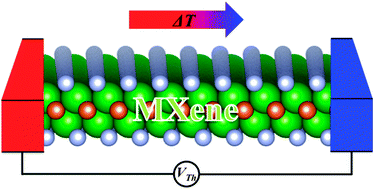Two-dimensional molybdenum carbides: potential thermoelectric materials of the MXene family†
Abstract
A newly synthesized family of two-dimensional transition metal carbides and nitrides, so-called MXenes, exhibit metallic or semiconducting properties upon appropriate surface functionalization. Owing to their intrinsic ceramic nature, MXenes may be suitable for energy conversion applications at high temperature. Using the Boltzmann theory and first-principles electronic structure calculations, we explore the thermoelectric properties of monolayer and multilayer M2C (M = Sc, Ti, V, Zr, Nb, Mo, Hf, and Ta) and M2N (M = Ti, Zr, and Hf) MXenes functionalized with F, OH, and O groups. From our calculations, it turns out that monolayer and multilayer nanosheets of Mo2C acquire superior power factors to other MXenes upon any type of functionalization. We therefore propose the functionalized Mo2C nanosheets as potential thermoelectric materials of the MXene family. The exceptional thermoelectric properties of the functionalized Mo2C nanosheets are attributed to the peculiar t2g band shapes, which are a combination of flat and dispersive portions. These types of band shapes allow Mo2C to gain a large Seebeck coefficient and simultaneously a good electrical conductivity at low carrier concentrations.


 Please wait while we load your content...
Please wait while we load your content...